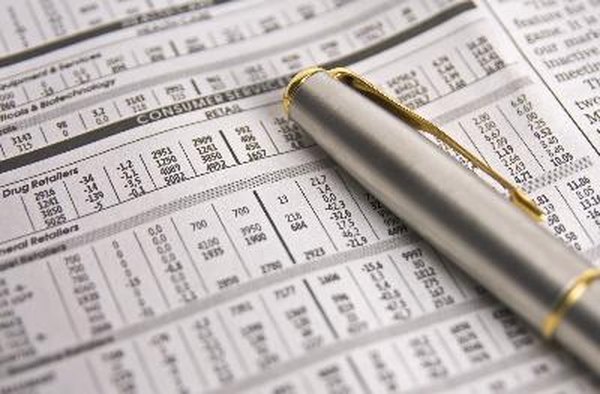How to Calculate the Value of Stock With the Price-to-Earnings Ratio
P/E ratios are widely reported in newspapers and on financial websites.
Stock charts with a gold and silver pen image by Victor Soares from Fotolia.com
The price-to-earnings ratio is one of the most common financial ratios used to value stocks. This ratio measures the price investors are willing to pay for each dollar of the company’s earnings per share, or EPS.
When investors like a company’s future growth potential, they will typically pay more for its stock, resulting in a high P/E ratio. High-risk companies with bleak outlooks typically trade at a low P/E. You can use P/E ratios to calculate a stock’s actual market value and to compare it with other stocks in the same industry.
Determining Stock Quotes
Visit any financial website that provides stock quotes and type a company’s name or its stock’s ticker symbol into the stock quote text box. Click “Get Quote” to bring up the stock’s main quote page. A ticker symbol consists of one or more capital letters that are typically related to the company’s name or business.
Finding a Company's EPS
Find the company’s trailing 12-month EPS by looking for its “TTM." This EPS is the profit the company has generated for every share of common stock outstanding over the past four quarters. For example, assume a company has a trailing 12-month EPS of $2.50.
Finding a Company's P/E Ratio
You'll find the stock’s trailing 12-month P/E ratio on the same page. In the above example, assume the stock has a trailing 12-month P/E ratio of 15. This means the market will pay $15 for each dollar of the company’s EPS.
Comparing a Competitor's P/E Ratio
Click “Competitors,” “Financial Ratios” or a similar link to view information about the company’s competitors. Identify the P/E ratio listed under “Industry,” which is the average P/E ratio of all companies in the industry.
If the stock’s P/E ratio is less than the industry average, the stock might be undervalued relative to its peers. If the stock’s P/E ratio is greater than the industry average, the stock might be overvalued. In the above example, assume the industry average P/E ratio is 18, which suggests the stock is possibly undervalued.
Determining Market Value Using P/E
Multiply the stock’s P/E ratio by its EPS to calculate its actual market value. In the above example, multiply 15 by $2.50 to get a market price of $37.50.
Determining Industry Average Price
Multiply the industry average P/E ratio by the stock’s EPS to estimate the price at which the stock would trade if its P/E ratio equaled the industry average. In general, companies in the same industry tend to trade at similar P/E ratios. If a stock’s P/E ratio is far off from the industry average, it might eventually – but not necessarily – realign with the industry average.
Concluding the example above, multiply 18 by $2.50 to get $45. This means the stock would rise from its current value of $37.50 and trade at approximately $45 if the market were to value it at the industry average P/E ratio.
A note of caution is that the industry average P/E ratio is only a guide to estimate a stock’s relative value. Some stocks continually trade at a P/E that differs from the industry average and might never align with their competitors.
References
Resources
Warnings
- The industry average P/E ratio is only a guide to estimate a stock’s relative value. Some stocks continually trade at a P/E that differs from the industry average and might never align with their competitors.

